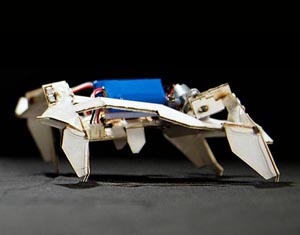Research Opens Door for Robotic Walking Papers

According to a recent ASME.org (American Society of American Engineers) article by independent writer Michael MacRae, engineers are rediscovering the timeless practicality of paper in the fabrication of smart, low-cost robots that walk, scoot, and grasp all by themselves. Experimental paper devices capable of unattended motion are under development in a number of labs, and may someday have legs in commercial applications.
As McRae points out, a sheet of paper can become almost anything the creator wants it to be. It’s light, flexible, and cheap. It can be cut, folded, stacked, or rolled into useful 3-D shapes. It can be engineered for extra rigidity, reflectivity, tensile strength, or other desirable properties, in combination with newer 2-D materials such as grapheme.
One such approach by professors Yong-Lai Zhang and Hong-Bo Sun of Jilin University, Changchun, China, could lead to a new category of fully autonomous, solar-powered paper sensors and MEMS devices. Their work exploits single-atom-thick graphene sheets to create paper devices that spring to artificial life in response to humidity changes in the air around them.
Sun, the director of JU’s Center for Ultrafast Optoelectronic Technologies, said his team’s ‘bots begin with graphene oxide (GO) paper exposed to UV radiation from sunlight. "We recently found that focused sunlight can reduce GO paper to some extent. Therefore, one side of the GO paper can be fully reduced due to the UV radiation-induced photochemical reactions, and the other side can survive as pristine GO."
This effect significantly alters the reduced graphene oxide (RGO) surface’s water-repelling capacity. Bilayers of RGO and GO react differently when approached with moisture, for example, an engineer’s sweaty finger, he said. "In response to moisture, the anisotropic water adsorption causes it to curl in seconds." The team has adapted the technology into robots that instantly morph from flat paper strips into inchworm-like crawlers that scoot across a surface, as into more complex autonomous claws that grasp and release tiny objects.
"Smart GO/RGO paper may find broad applications in intelligent devices," Sun said. "For example, sensors, MEMS, smart textiles, tissue engineering, and even robotics."
What could be a more natural addition to the paper robotics fold than a device that actually folds itself up? Such a device developed at Harvard’s Wyss Institute for Biologically Inspired Engineering captured national headlines last year. The origami-inspired automaton is a useful byproduct of the institute’s long-standing effort to develop robotic insects, but it could have a life of its own in applications where robots are sent into environments where people can’t go – other planets, for instance. Space-confined craft could hold several flattened robots that self-deploy and go about their duties without human aid.
To demonstrate that concept, graduate student Samuel Felton used the mathematics of origami to calculate a paper-folding pattern that would produce a self-propelled droid. His device begins as a perfectly flat planar surface with a few protruding electronics on top to provide power and programming. But flipping the switch sends the device into a tightly choreographed four-minute metamorphosis of folding that culminates with a colorful, crab-walking quadruped.
The self-folding action is courtesy of the substrate’s unusual composition: a sandwich of ordinary paper, a flexible circuit board, and a sheet of contractile pre-stretched polystyrene (PSPS) – better known to generations of crafty kids as Shrinky Dinks. Together, the materials form a shape-memory composite multilayer cut to the appropriate shape to facilitate folding. Embedded, heat-responsive hinges placed along the fold lines enable the PSPS layer to bend into the desired position when heated to 100oC, creating rigid folds once cooled. The microprocessor controls the precise heating/folding sequence based on preprogrammed steps determined through computational origami. The result is sturdy 3-D object that scurries into action without any operator intervention. By choosing different shape-memory materials and more elaborate programming, the team said self-folding robots could be engineered for almost any purpose.
These paper ‘bots are the vanguard of a coming wave of useful devices, microfluidics, and medical diagnostics. Paper meets a number of key engineering and economic criteria for devices that may help developing nations address problems in health care, environmental monitoring, and energy storage. But communication across this multidisciplinary community can be difficult. It doesn’t help matters that researchers trying to search the scientific literature using keywords like "paper" typically end up with a long list of irrelevant citations in which the word appears as a synonym for "article."
The photo below shows the self-folding mobile prototype developed by researchers at MIT and Harvard. Image: Harvard’s Wyss Institute.
TAPPI
http://www.tappi.org/
 According to a recent ASME.org (American Society of American Engineers) article by independent writer Michael MacRae, engineers are rediscovering the timeless practicality of paper in the fabrication of smart, low-cost robots that walk, scoot, and grasp all by themselves. Experimental paper devices capable of unattended motion are under development in a number of labs, and may someday have legs in commercial applications.
According to a recent ASME.org (American Society of American Engineers) article by independent writer Michael MacRae, engineers are rediscovering the timeless practicality of paper in the fabrication of smart, low-cost robots that walk, scoot, and grasp all by themselves. Experimental paper devices capable of unattended motion are under development in a number of labs, and may someday have legs in commercial applications.